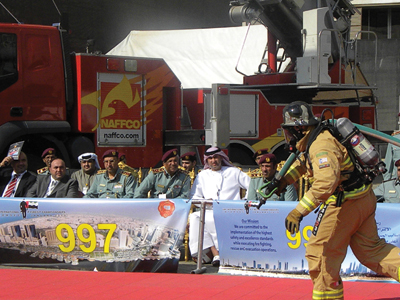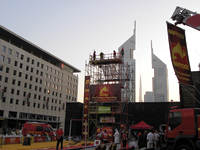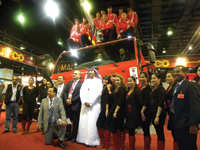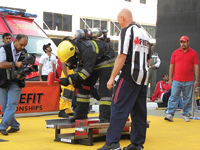
Features
Health and wellness
Hot topics
FireFit goes global
This story is about perseverance, about having a dream and making it happen. In 1998, Mohammed Al Ahmadi of the United Arab Emirates was a student of mine at the Toronto Fire Academy.
October 18, 2010
By Peter Sells
This story is about perseverance, about having a dream and making it happen. In 1998, Mohammed Al Ahmadi of the United Arab Emirates was a student of mine at the Toronto Fire Academy. Along with 11 of his peers, Al Ahmadi was a junior officer with the Dubai Civil Defence fire service. The students spent more than 16 months in Canada developing their skills and knowledge as firefighters, instructors and officers. During that time, Al Ahmadi was exposed to the FireFit training being done at the academy by the Toronto Fire Department FireFit team. He and a few of his buddies tried the event and Al Ahmadi was struck by the idea of bringing the competition to his home country.
Al Ahmadi returned to Dubai Civil Defence, leaving its employ a few years later to become the fire chief of the Dubai Aluminum Company plant and, ultimately, the fire chief of the Dubai Electric and Water Authority. He and I remained in contact over the years, and eventually formed a business partnership to work on fire/rescue training projects in the United Arab Emirates and around the Gulf region. Unbeknownst to me, he also stayed in touch with Dale McRoberts, the president of FireFit of Canada Ltd. So I was quite surprised to run into Dale at the Dubai World Trade Centre at the Intersec Expo in January 2009.
 |
| An Emirati competitor passes in front of the VIP viewing area at the inaugural FireFit competition in Dubai in July – 997 is the fire emergency telephone number in the UAE. Photo by Peter Sells |
The FireFit skills competition, in which a sequence of six firefighting and rescue tasks are performed head-to-head and against the clock, is well-known in Canada. FireFit of Canada has been taking the competition across the country since 1994, drawing huge crowds in big cities and small towns, and a nationwide TV audience for the annual broadcast of the Canadian Championships. Canadian FireFit competitors are among the fastest in the world.
Intersec is a prominent conference and trade show focusing on fire protection, law enforcement, security and industrial health and safety. McRoberts was there to talk in the exhibitors’ forum about FireFit, demonstrate some of the individual tasks included in the competition and set the wheels in motion for a full FireFit competition to be held in conjunction with Intersec 2010. The idea was well-received, but having a good idea and implementing it are often two different animals, especially when a high degree of organizational commitment is required. Al Ahmadi was able to convince Dubai Civil Defence, and its counterparts in the rest of the United Arab Emirates, to allow their firefighters to train towards competing in FireFit. McRoberts and I returned a few months later and set up a training course at the Dubai Civil Defence training centre. McRoberts began training several dozen firefighters – primarily from the large urban centres of Dubai and Abu Dhabi – as well as a few from the small emirate of Ajman, in the techniques and physical demands of FireFit competition.
In late August 2009, Al Ahmadi came to Canada, along with six Emirati firefighters, to have a joint UAE team enter the FireFit Canadian Championships in Gaspé, Que. The team was well received by the Canadian competitors and by the community (especially by the staff at Tim Hortons). Gaspé presented a unique opportunity in that the Eastern Quebec regional competition and the Canadian championships took place there in successive weeks. The young Arabs were taken under the wing of the Canadian competitors, with a great deal of peer coaching in the days leading to the opening buzzer. For rookies, the UAE team acquitted themselves admirably. As McRoberts expected from the training runs, Hassan Al Balooshi of Dubai achieved the first Middle East record time of 2:05:15 to take home the bragging rights.
 |
|
| The spectacular FireFit venue at Intersec 2010, with the Emirates Towers framing the Burj Khalifa (world’s tallest structure) in the background. hoto by Peter Sells |
Armed with some new-found confidence from Gaspé, the UAE team returned home to begin preparation for the next phase. Mohammed had been working feverishly to secure official support and corporate sponsorship for a UAE FireFit Championship to be held in January 2010. With the buy-in of Dubai Civil Defence and the UAE Ministry of the Interior, as well as the support of partners such as Intersec and NAFFCO (a UAE-based fire equipment and apparatus supplier), we were able to commit to bringing 15 Canadian competitors, among them FireFit veteran Randy Kalan. Kalan and I went over on New Year’s Day, which allowed us to witness the spectacular opening of Burj Khalifa, the world’s tallest building, on January 4. I went back to the training centre with Kalan and we rehabbed the training course that McRoberts and I had prepared – it’s amazing what nine months of sand and blazing sun can do to spray painted markings on concrete.
As Al Ahmadi and I carried on with the business side of things, Kalan spent the next two weeks putting as many as 45 young firefighters through their paces. Hassan was among them, and was afforded quite a bit of respect from his peers based on his success in Canada. Then a van full of firefighters from Germany and Austria, who were working in the northern emirate of Ras Al Khaimah, showed up and asked if it was too late to sign up. They, along with another German group working in Abu Dhabi, made it a truly international competition. Regardless, at the age of 49, Kalan was literally the last man standing on every training day. Aside from Kalan, the fastest times on our training course were consistently put in by Hassan, until week two. Again, out of nowhere, a new competitor showed up, this time from the eastern emirate of Fujairah. With no experience, Ahmed Alwan started putting up some very competitive times, earning the nickname The Fujairah Flash.
All the while that Kalan was conducting the training camp, logistical preparations were underway for the competition at Intersec. McRoberts and his wife, Hilary, had weeks earlier packed the FireFit course equipment into a marine container, which was on its way to the enormous Jebel Ali port southwest of Dubai. Mohammed had arranged for a local scaffolding company to erect a double set of stairs and balcony, to specifications supplied by the McRoberts. With a few days to go before the competition, the McRoberts arrived, followed closely by the 15 Canadian competitors. All we needed now was the marine container.
As this was the first experience for all of us with international shipping, we assumed that the additional time Hilary had allowed for in getting the equipment on its way was more than adequate. You can track a ship on the sea online in much the same way that you can track a package sent by courier, so we were aware that the ship carrying the FireFit container had been delayed in Singapore for almost a week. It was still expected to arrive at Jebel Ali before Intersec, but it was going to be very tight. We had hoped to have the course set up by Thursday, Jan. 14, to allow for two days of practice before the competition on the Sunday and Monday of Intersec, but the ship did not arrive until Friday, Jan. 15. Al Ahmadi and representatives from NAFFCO negotiated frantically with the port to get the ship moved up in the queue, and the container arrived at the Dubai World Trade Centre on Saturday, Jan. 16. With many hands available, the course was set up quickly.
After an impressive opening ceremony in which the senior officers of Dubai Civil Defence and other government dignitaries were marched in, individual competition got underway. As is the usual practice, competitors were paired up according to their expected times. The Canadians’ past times were well-known. Kalan had been keeping track of performances during training, and McRoberts had had a chance to observe the locals and Europeans for a couple of days. Still, when dealing with new competitors, there can be surprises. Some of the Europeans had been steadily improving and generally seemed better able to budget their energy over the entire course. Overall, it was expected that the times for the top competitors would be slower than in Canadian competition, due to the configuration of the scaffold. I asked world champion Dwayne Drover of Waterloo Fire about the time difference, and he indicated that the top competitors were coming off the stairs at around 41 or 42 seconds, compared to their usual 31 seconds when using the FireFit tower in Canada. So, as a rule of thumb, we were looking for winning times of about 1:30 and still hoping that the fastest time for a local competitor would be about 2:00 (based on Hassan’s 2:05 from Gaspé).
 |
|
| Canadian firefighters received rockstar treatment at Intersec 2010. Photo by Peter Sells |
The Canadians did not disappoint, posting the top 15 individual times. The top three were Joe Triff of Halifax Regional Fire at 1:28.26, Bob Murray of Edmonton Fire & Rescue at 1:32.30 (the fastest over-40 time) and Darren Hillman of Windsor Fire & Rescue at 1:33.22 (also over 40), nipping Drover by 0.03 seconds. The fastest over-45 time was put in by Delta Fire’s Mark Millward at 1:55.80, with Halifax’s Cyril Fraser at 1:52.55, claiming the over-50 top result.
Hassan retained his crown as the fastest Emirati at 2:09.04, which was a six-second improvement from Gaspé, when the scaffold is factored in. However, Alexander Ruppert (one of the German imports from Quick Intervention Abu Dhabi) at 2:06.96 was the fastest UAE firefighter. Ahmed, the Fujairah Flash, followed them closely with a very good rookie run at 2:10.87.
It had been decided in advance that the Canadian competitors’ times would not be included in team results, since there were not a minimum of three from any one fire service. Also, it was important that the UAE firefighters were able to achieve some concrete success and establish some benchmark times for future competitions.
 |
|
| An Emirati competitor hammers the force machine, watched by referee/coach Randy Kalan and local sports media. Photo by Peter Sells |
I want to close with my three star selections for the Dubai FireFit Championships. La troisième étoile, the third star: Dwayne Drover, a.k.a. “Mankhool”. Our host hotel was in the Al Mankhool section of Bur Dubai, one of the older parts of the city. Drover claimed the nickname upon seeing the road sign. His star selection, however, is on the recommendation of all of the skinny stray cats of Al Mankhool who appreciated the bag of catfood that he bought and spread through the alley next to our hotel. La deuxième étoile, the second star: the indefatigable Randy Kalan, for all of his work and inspiration. Et la première étoile, the first star: Firefighter Saeed Al Mahiri of the tiny emirate of Ajman. Saeed had competed in Gaspé in the relay and had obviously worked very hard in the intervening months to prepare for individual competition. Despite this effort, he was unable to complete his race after dropping the Rescue Randy several times and having nothing left with which to continue. Al Mahiri earns the star for insisting on a chance to try again the next day before the team competition, alone against the clock in an unofficial race. He completed the course and won my respect for embodying the spirit of FireFit. His accomplishment will not show in the scoring tables, but it is the best example of what we were hoping to achieve.
Retired District Chief Peter Sells writes, speaks and consults on fire service management and professional development across North America and internationally. He holds a B.Sc. from the University of Toronto and an MBA from the University of Windsor.
Print this page